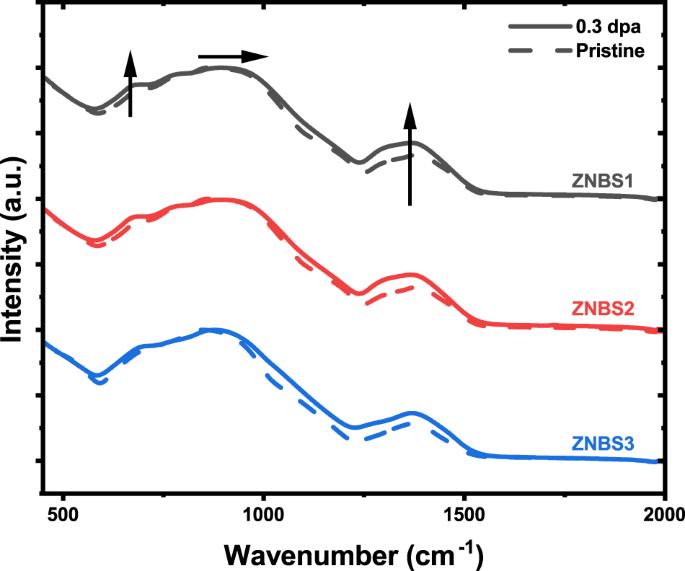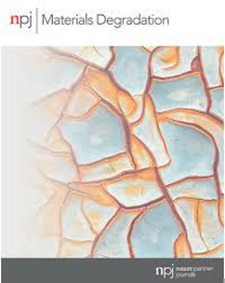辐射对硼硅玻璃浸出行为的影响
IF 6.6
2区 材料科学
Q1 MATERIALS SCIENCE, MULTIDISCIPLINARY
引用次数: 0
摘要
玻璃化技术被公认为是世界范围内对高放射性废物(HLW)进行地质处置的一种可行方法。为确保放射性废物的安全处置,用于玻璃化高放射性废物的硼硅玻璃必须具有优异的耐水性,以防止地下水腐蚀和随后的放射性泄漏。辐射可能会改变硼硅玻璃的耐水性。我们利用一系列辐照剂量为 0.3 dpa 的含锆硼硅酸盐玻璃来研究辐射对玻璃-水相互作用的影响。扫描电子显微镜 (SEM)、飞行时间二次离子质谱 (ToF-SIMS)、X 射线光电子能谱 (XPS)、电感耦合等离子体光学发射光谱 (ICP-OES) 和傅立叶变换红外光谱 (FTIR) 被用来研究未辐照和辐照样品的浸出行为。浸出样品的深度剖面表明,玻璃与水之间的相互作用以相互扩散为主。傅立叶变换红外光谱和 ICP-OES 的结果表明,经过辐照后,初始浸出率增加了三倍。此外,还介绍了不同锆含量对硼硅玻璃耐水性的影响。本文章由计算机程序翻译,如有差异,请以英文原文为准。

Influence of radiation on borosilicate glass leaching behaviors
Vitrification is widely recognized as a promising method for the geological disposal of high-level radioactive waste (HLW) worldwide. To ensure the safe disposal of radioactive waste, the borosilicate glass that vitrifies HLW must exhibit exceptional water resistance to prevent the possibility of groundwater corrosion and subsequent radioactive leaks. Radiation might change the water resistance of borosilicate glass. A series of zirconium-containing borosilicate glass with an irradiation dose of 0.3 dpa were utilized to examine the radiation effect on glass-water interaction. Scanning electron microscopy (SEM), Time-of-Flight Secondary ion mass spectrometry (ToF-SIMS), X-ray photoelectron spectroscopy (XPS), Inductively Coupled Plasma Optical Emission spectroscopy (ICP-OES) and Fourier transform infrared spectroscopy (FTIR) were used to investigate the leaching behavior of the non- and irradiated samples. The depth profile of the leached samples implied the interdiffusion dominated glass-water interaction. The results from FTIR and ICP-OES indicated that, after irradiation, the initial leaching rate increased by threefold. Additionally, the impact of different zirconium contents on the water resistance of borosilicate glass was also presented.
求助全文
通过发布文献求助,成功后即可免费获取论文全文。
去求助
来源期刊

npj Materials Degradation
MATERIALS SCIENCE, MULTIDISCIPLINARY-
CiteScore
7.80
自引率
7.80%
发文量
86
审稿时长
6 weeks
期刊介绍:
npj Materials Degradation considers basic and applied research that explores all aspects of the degradation of metallic and non-metallic materials. The journal broadly defines ‘materials degradation’ as a reduction in the ability of a material to perform its task in-service as a result of environmental exposure.
The journal covers a broad range of topics including but not limited to:
-Degradation of metals, glasses, minerals, polymers, ceramics, cements and composites in natural and engineered environments, as a result of various stimuli
-Computational and experimental studies of degradation mechanisms and kinetics
-Characterization of degradation by traditional and emerging techniques
-New approaches and technologies for enhancing resistance to degradation
-Inspection and monitoring techniques for materials in-service, such as sensing technologies
 求助内容:
求助内容: 应助结果提醒方式:
应助结果提醒方式:


